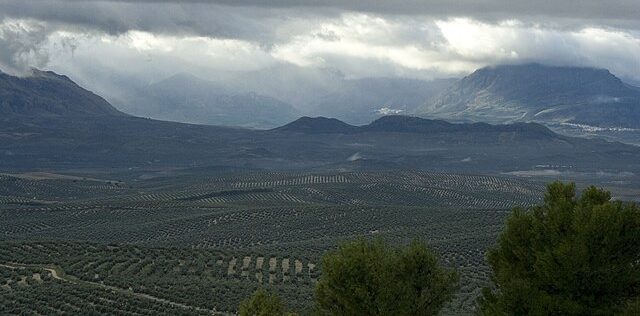Farmers in the southwestern Spain olive heartland of Andalusia are denouncing plans to install eight solar power projects here.
This is happening at a time when olive oil rates are back to earth after experiencing highs through 2024.
But keen to reap the 3,000 sunlight hours that this Mediterranean area receives yearly, industrialists could cost the region’s olive sector millions of euro.
Olive oil co-op La Loperana estimates that just a 500-hectare takeover could cost €2 million ($2.3 million) annually.
Regional farmers also foresee losses of about 100,000 trees while the Andalusia government cites only 13,000 trees.
Law, Protests and Media
It is to avert these projects that cooperatives and other stakeholders have filed lawsuits, with no verdicts yet.
Alongside the lawsuits are growers from the township of Lopera in Andalusia, who are taking the campaign to the media. One informed AFP on April 13, 2025 that the takeover is tantamount to a crime as it touches generational land.
Companies that have applied for solar farm tenders in the Lopera vicinity include FRV Arroyadas and Greenalia.
The antitrust against the entities aims to save some 1,000 hectares of property, according to tallies by Lopera’s residents.
Solar Boom
The government meanwhile is seeing massive gains in renewable power, whose generation has surpassed mainstream electric sources.
In 2024, wind and solar energy contributed 56.8% of the national electricity grid, an unprecedented high.
With a vision to eradicate harmful emissions, Spain intends to bring the renewable energy grid share to 81% by 2030.
One way to reach the target is portioning around 1% off the sunny lands of places such as Lopera.
For now, both the Spain olive sector and the government face a dilemma as how to transition conveniently to solar. Can it be done without hurting a multi-million-euro industry dependent on lucrative olive oil prices ? The statistics below illustrate this point by revisiting the current revenue base of the olive sector.
Spain Olive Revenue Statistics
Table olive and olive oil exports generate phenomenal revenue for world production leader, Spain, in a good year. For example in the 2023-24 market year, the country managed €6 billion ($6.9 billion) in olive oil exports despite drought.
Table olives on the other hand bring some €734.9 million ($846.3 million) in revenue from a volume of 313,920 tonnes (2019-20). According to the Olive Oil Council, these returns place Spain as the world leader for both table olives and olive oil export values.
Do olive oil prices buoy the sector’s returns?
Prices in the olive oil industry are usually high during shortage such as in 2024, and therefore rally revenue. For example, although annual production fell from 1,491,500 tonnes to 84,000 tonnes in 2023-24, prices buoyed revenue. In the 2023-24 context, prices averaged €8 ($9.21) a kg, insuring the good total returns for the year.
How beneficial is olive oil to the Andalusia economy?
As the world’s biggest single source of olive oil, the autonomous region of Andalusia now labels the oil “liquid gold.” This label fits the billing for it generates some €4.25 billion ($4.89 billion), as for the first 11 months of 2024. This represents almost half of the total agricultural revenue of the region of €10.4 billion ($11.97 billion), as of 2022.
